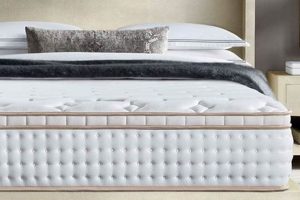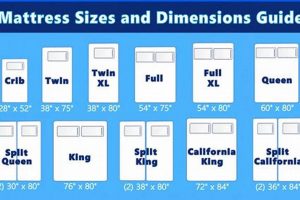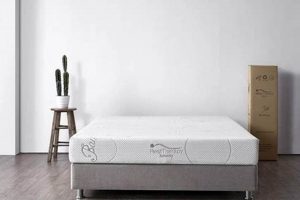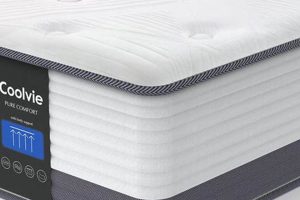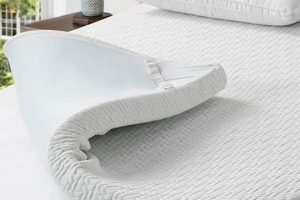A cushioning layer, measuring six inches in thickness, designed to be placed atop a mattress. Its primary function is to augment the comfort and support provided by the underlying sleep surface. Examples include memory foam, latex, and down alternatives crafted to this specific depth, each offering varying degrees of contouring and pressure relief.
The incorporation of such a sleep aid can significantly improve sleep quality and address various concerns, such as a mattress that is too firm or lacking adequate support. Its use can extend the lifespan of the original mattress by reducing wear and tear, and it offers a more cost-effective alternative to replacing the entire mattress. Historically, simpler versions of these bedding components were employed to mitigate the discomfort of rudimentary sleeping arrangements.
The subsequent sections will delve into the diverse materials used in their construction, examining the specific features and advantages of each. Further analysis will address considerations for selecting the appropriate option based on individual sleep preferences and needs, and explore factors to consider when evaluating the overall value and longevity.
Optimizing the Use of a Six-Inch Mattress Topper
The following guidelines are provided to ensure proper selection, usage, and maintenance, maximizing the benefits derived from this bedding component.
Tip 1: Material Selection Based on Sleep Style: Consider the sleeper’s preferred sleeping position when choosing the material. Side sleepers may benefit from the contouring of memory foam, while back and stomach sleepers might prefer the firmer support of latex or a hybrid material.
Tip 2: Assessment of Underlying Mattress Condition: Evaluate the existing mattress for significant sagging or structural damage. While a six-inch topper can improve comfort, it will not fully compensate for a severely compromised mattress.
Tip 3: Proper Installation and Securing: Ensure the bedding component is correctly aligned with the edges of the mattress. Use fitted sheets with deep pockets to secure the topper and prevent shifting during sleep.
Tip 4: Regular Rotation for Even Wear: Rotate the topper every three to six months. This practice promotes uniform wear and extends the product’s lifespan by preventing localized compression.
Tip 5: Consistent Cleaning and Maintenance: Follow the manufacturer’s instructions for cleaning. Spot clean spills immediately with a mild detergent and water. Vacuum regularly to remove dust mites and allergens.
Tip 6: Consideration of Body Weight and Firmness: Individuals with higher body weights may require a firmer density to provide adequate support and prevent excessive sinking. Choose a density that aligns with personal preference and weight distribution.
Tip 7: Evaluation of Temperature Regulation Properties: Some materials, such as memory foam, can retain heat. If overheating is a concern, consider options infused with gel or designed with open-cell structures to promote airflow.
Adherence to these guidelines will promote optimal performance, longevity, and comfort when utilizing a six-inch topper. Careful consideration during selection and consistent maintenance are crucial for realizing the full benefits of this bedding enhancement.
The subsequent section will discuss specific brands and models currently available, highlighting their unique features and benefits.
1. Thickness and Support
The relationship between thickness and support is fundamental to the effectiveness of any mattress topper. In the context of a six-inch mattress topper, this relationship is especially significant, dictating the degree of comfort, pressure relief, and overall spinal alignment it can provide.
- Core Material Density and Load-Bearing Capacity
The density of the core material directly influences the load-bearing capacity of the topper. High-density foams, for example, offer greater resistance to compression, providing firmer support and preventing excessive sinking. This is particularly important for heavier individuals who require robust support to maintain proper spinal alignment. Conversely, low-density materials may offer a softer feel but could lack the necessary support, leading to discomfort and potential back pain.
- Layering and Zonal Support Systems
A six-inch topper may incorporate multiple layers of varying densities to achieve targeted support. Zonal support systems, where specific areas of the topper are engineered with different firmness levels, can address the unique support needs of different body regions. For instance, a firmer section in the lumbar region can promote proper spinal alignment for back sleepers, while softer sections in the shoulder and hip areas can alleviate pressure points for side sleepers.
- Impact on Spinal Alignment and Posture
The thickness and support characteristics of the topper directly impact spinal alignment. An inadequate topper can lead to spinal misalignment, resulting in back pain, neck stiffness, and other musculoskeletal issues. A properly designed six-inch topper, on the other hand, can promote neutral spinal alignment, reducing pressure on the spine and alleviating discomfort. The degree of support required varies depending on individual body weight, sleeping position, and pre-existing conditions.
- Edge Support and Usable Surface Area
While the core focuses on sleep surface support, edge support determines the usable area. A six-inch topper with weak edges results in a feeling of roll-off, limiting accessible space and hindering sleep, especially for couples or those who move during sleep. Reinforced edge support enhances stability, maximizing the effective sleep area and prevents sagging over time.
In summary, the thickness and support characteristics of a six-inch mattress topper are critical determinants of its performance. Careful consideration of core material density, layering techniques, and zonal support systems is essential for selecting a topper that provides adequate comfort, spinal alignment, and pressure relief. The interaction of these factors directly influences the overall quality of sleep and long-term health of the sleeper. Different materials affect the cost. For instance, latex 6 inch mattress topper more expensive.
2. Material Composition
The material composition of a six-inch mattress topper is a primary determinant of its performance characteristics, influencing factors such as comfort, support, temperature regulation, and durability. The selection of specific materials, or combinations thereof, dictates the topper’s ability to conform to the body, alleviate pressure points, and maintain a comfortable sleep environment. A topper constructed from high-density memory foam, for example, will exhibit a different feel and response compared to one made from latex or a down alternative. The choice of material is therefore a critical consideration, directly impacting the user’s sleep experience and overall satisfaction. Inadequate material selection can result in discomfort, poor spinal alignment, and premature degradation of the topper.
Consider, for instance, a six-inch topper intended for individuals with chronic back pain. A memory foam construction with zoned support could provide targeted cushioning and pressure relief to sensitive areas, promoting spinal alignment and reducing discomfort. Alternatively, a latex topper may offer a more responsive and buoyant feel, which some users find preferable. Conversely, a topper made from low-quality polyurethane foam may offer limited support and comfort, and could quickly lose its shape and resilience over time. The construction also impacts the price. The cost to produce the memory foam 6 inch mattress topper different to down 6 inch mattress topper.
In conclusion, the material composition is an indispensable factor in the performance of a six-inch mattress topper. It dictates its comfort level, support characteristics, and longevity. While various material options are available, each with its own set of advantages and disadvantages, understanding these nuances is crucial for selecting a topper that meets individual needs and preferences. Failure to consider material composition can lead to a compromised sleep experience and a reduced lifespan for the bedding component. Further research into material properties, such as density, resilience, and breathability, can significantly enhance the decision-making process.
3. Pressure Relief
A six-inch mattress topper, due to its added thickness, inherently offers increased potential for pressure relief compared to thinner alternatives. Pressure relief, in this context, refers to the ability of the topper to redistribute body weight, minimizing concentrated stress on areas such as the hips, shoulders, and knees. This redistribution is achieved through the topper’s capacity to conform to the contours of the body, effectively cushioning bony prominences and preventing the build-up of pressure that can lead to discomfort, pain, and even the development of pressure ulcers. Material composition plays a crucial role in determining the degree of pressure relief provided; viscoelastic foams, for instance, are known for their superior contouring abilities. A six-inch profile allows for a greater volume of these materials, enhancing their capacity to alleviate pressure.
The practical significance of pressure relief is particularly evident in individuals with conditions such as arthritis, fibromyalgia, or those recovering from surgery. These individuals often experience heightened sensitivity to pressure, making a supportive and pressure-relieving sleep surface essential for comfort and rest. For example, a patient recovering from hip surgery may find that a six-inch memory foam topper effectively minimizes pressure on the surgical site, facilitating more comfortable sleep and promoting healing. Similarly, individuals with arthritis may experience reduced joint pain and stiffness due to the topper’s ability to cushion and support their joints. The effectiveness of a pressure-relieving topper also hinges on its density and firmness, requiring careful consideration of individual body weight and sleeping preferences.
In summary, the enhanced thickness of a six-inch mattress topper provides a significant advantage in terms of pressure relief, offering a cost-effective means of improving sleep quality and alleviating discomfort for a wide range of individuals. While material composition and firmness are critical factors to consider, the increased volume of cushioning material afforded by the six-inch profile contributes significantly to its pressure-relieving capabilities. Understanding the connection between topper thickness and pressure relief enables informed decision-making, leading to a more comfortable and restorative sleep experience. Further considerations include the long-term durability of the materials and any potential off-gassing that may occur.
4. Temperature Regulation
The thermal properties of a six-inch mattress topper are integral to sleep comfort. Material selection critically influences temperature regulation. Certain materials, such as traditional memory foam, tend to retain heat due to their dense, closed-cell structure. This can create an uncomfortably warm sleep environment, leading to restlessness and disrupted sleep cycles. Conversely, materials like latex, particularly Dunlop latex, and open-cell memory foam promote airflow, facilitating heat dissipation and maintaining a cooler sleep surface. The increased thickness of a six-inch topper can exacerbate or mitigate these inherent thermal characteristics, depending on the constituent materials. For example, a six-inch closed-cell memory foam topper may intensify heat retention, while a six-inch latex topper can provide a more significant cooling effect due to its inherent breathability. The presence of cooling gels or phase-change materials within the topper further enhances its temperature-regulating capabilities.
The practical implications of temperature regulation are significant for individuals prone to night sweats or those living in warmer climates. A six-inch topper with poor thermal properties can exacerbate these issues, leading to chronic sleep disturbances. Choosing a topper with enhanced breathability and cooling features can mitigate these problems, promoting a more restful and comfortable sleep experience. Consider the case of an individual experiencing menopause-related hot flashes. A six-inch latex topper with a breathable cover can significantly reduce the frequency and intensity of these episodes, leading to improved sleep quality and overall well-being. Similarly, athletes who tend to sleep hot may benefit from a topper designed to dissipate heat and maintain a cooler core temperature, aiding in recovery and performance. Furthermore, the effectiveness of temperature regulation is contingent on factors such as room temperature, bedding materials, and individual physiology.
In summary, temperature regulation is a crucial consideration when selecting a six-inch mattress topper. Material composition and construction play a pivotal role in determining the topper’s thermal properties, which directly impact sleep comfort and overall health. Individuals should carefully evaluate their individual needs and preferences when choosing a topper, taking into account factors such as climate, physiology, and pre-existing conditions. Selecting a topper with appropriate temperature-regulating features can significantly improve sleep quality, promoting well-being and enhancing overall quality of life. The inclusion of innovative materials and design elements, such as cooling gels and open-cell structures, continues to drive advancements in topper technology, offering consumers a wider range of options tailored to their specific needs.
5. Durability
The longevity of a six-inch mattress topper is a critical attribute directly affecting its cost-effectiveness and sustained performance. The term “durability,” in this context, refers to the topper’s ability to resist degradation, maintain its structural integrity, and retain its original performance characteristics over an extended period of use. Material composition, construction methods, and usage patterns are key factors influencing the durability of a six-inch topper. For instance, a topper constructed from high-density latex is generally more resistant to compression and sagging compared to one made from low-density polyurethane foam. Similarly, a topper with reinforced seams and a high-quality cover is less likely to tear or unravel over time. Constant and repeated use, body weight, and even environmental factors contribute to the rate of wear and tear of the material which affects the lifespan and quality.
A practical example illustrates this point: Consider two individuals purchasing seemingly identical six-inch memory foam toppers. One topper, made from high-density, CertiPUR-US certified foam, maintains its shape and support for several years, providing consistent comfort and pressure relief. The other, made from a lower-density, non-certified foam, quickly develops indentations and loses its supportive properties, requiring replacement within a year. This difference in durability translates directly into cost savings for the individual who invested in the higher-quality topper. In a commercial setting, such as a hotel, the durability of mattress toppers is even more critical, as frequent use and varying body weights accelerate wear and tear. Selecting durable toppers in such environments minimizes replacement costs and ensures consistent guest satisfaction.
In conclusion, durability is an essential consideration when evaluating a six-inch mattress topper. The initial purchase price is only one factor; the long-term cost of ownership is significantly influenced by the topper’s ability to withstand wear and tear. Challenges in assessing durability prior to purchase exist, as manufacturers’ specifications and certifications are key indicators, while user reviews and warranty information can provide valuable insights. Prioritizing durability leads to a more sustainable and cost-effective investment, ensuring consistent comfort and support for years to come. A regular 6 inch mattress topper should be maintained properly in order to prevent damage and promote durability.
6. Size Compatibility
The precise dimensions of a six-inch mattress topper must correspond accurately with the underlying mattress to ensure optimal performance, longevity, and user satisfaction. Incompatibility in size can compromise support, diminish comfort, and accelerate wear. Therefore, meticulous attention to size compatibility is paramount during the selection process.
- Standard Mattress Dimensions and Topper Overhang
Standard mattress sizes (Twin, Twin XL, Full, Queen, King, California King) have established dimensions. A six-inch topper must precisely match these dimensions to avoid overhang or undersizing. Overhang can create unstable edges, increasing the risk of rolling off and accelerating wear on the topper’s perimeter. Undersizing results in exposed sections of the mattress, negating the intended benefits of the topper in those areas. For example, a Queen-size topper placed on a Full-size mattress will inevitably overhang, while a Full-size topper on a Queen-size mattress will leave portions of the underlying mattress uncovered.
- Thickness and Fitted Sheet Compatibility
While the length and width must correspond, the six-inch thickness also necessitates the use of fitted sheets with deep pockets. Standard fitted sheets designed for traditional mattresses may not adequately accommodate the added height, leading to improper fit, difficulty in securing the sheet, and increased wear on the sheet itself. Failure to use appropriate deep-pocket sheets can compromise the topper’s performance and reduce its lifespan. The sizing is especially important when purchasing gel memory foam 6 inch mattress topper because they are thicker.
- Weight Distribution and Edge Support Considerations
If a topper’s dimensions do not align with the mattress, weight distribution becomes uneven, potentially compromising edge support. The topper may sag or compress disproportionately in certain areas, reducing overall support and comfort. This is particularly relevant for couples or individuals who utilize the full surface area of the mattress. Mismatched sizes can also undermine the intended benefits of specialized zones within the topper, such as lumbar support regions, as these zones may not align correctly with the sleeper’s body.
- Impact on Mattress Protector Fit
Similar to fitted sheets, mattress protectors must also be appropriately sized to accommodate the six-inch topper. A protector that is too small will be difficult to install and may not adequately protect the mattress and topper from spills and stains. A protector that is too large may bunch up, creating discomfort and interfering with the topper’s performance. Choosing a protector specifically designed for thicker mattresses and toppers is essential for maintaining hygiene and protecting the investment.
The compatibility of a six-inch mattress topper extends beyond simple dimensional measurements. Ensuring the topper’s dimensions align precisely with the mattress and accommodating its thickness with appropriately sized bedding is crucial for maximizing comfort, support, and longevity. Neglecting these considerations can compromise the topper’s performance, accelerate wear, and undermine its intended benefits. This size is important to note especially when ordering a new complete bed set, mattress encasement, 6 inch mattress topper, box spring, metal bed frame.
Frequently Asked Questions
The following section addresses common inquiries regarding six-inch mattress toppers, offering clarity on their features, benefits, and suitability for various sleep needs.
Question 1: What advantages does a six-inch mattress topper offer compared to thinner options?
A six-inch mattress topper generally provides enhanced support and pressure relief due to its increased volume of cushioning material. This added thickness can more effectively contour to the body, alleviating pressure points and promoting spinal alignment, particularly for side sleepers or individuals with back pain.
Question 2: Can a six-inch mattress topper salvage a significantly sagging or damaged mattress?
While a six-inch topper can improve the comfort of a worn mattress, it cannot fully compensate for significant structural damage or sagging. A severely compromised mattress requires replacement to ensure adequate support and prevent further discomfort or potential health issues.
Question 3: Are all six-inch mattress toppers compatible with standard fitted sheets?
Standard fitted sheets may not always accommodate the added thickness of a six-inch topper. Deep-pocket fitted sheets are generally required to ensure a secure and proper fit, preventing the sheet from slipping or bunching.
Question 4: How does the material composition of a six-inch mattress topper affect its temperature regulation properties?
Different materials exhibit varying degrees of temperature regulation. Traditional memory foam tends to retain heat, while latex and open-cell foams promote airflow and heat dissipation. Consider individual temperature preferences and potential for overheating when selecting a topper material.
Question 5: What is the typical lifespan of a six-inch mattress topper, and how can its longevity be maximized?
The lifespan of a six-inch topper varies depending on material quality, usage patterns, and maintenance. Regular rotation, proper cleaning, and the use of a mattress protector can help extend its lifespan. High-density materials generally exhibit greater durability.
Question 6: Does a six-inch mattress topper require special cleaning or maintenance procedures?
Specific cleaning and maintenance instructions vary depending on the topper material. Generally, spot cleaning with a mild detergent and water is recommended for spills. Vacuuming regularly can help remove dust and allergens. Consult the manufacturer’s instructions for specific care guidelines.
Proper selection and maintenance are critical for maximizing the benefits and lifespan of a six-inch mattress topper.
The subsequent section will explore consumer reviews and ratings of various six-inch mattress topper models.
6 inch mattress topper
This exploration has elucidated the multifaceted aspects of the 6 inch mattress topper, emphasizing material composition, support characteristics, temperature regulation, durability, and size compatibility as paramount considerations. The benefits of enhanced pressure relief and potential for improved sleep quality were also highlighted. It is evident that selecting an appropriate model requires careful evaluation of individual needs and preferences.
In light of these considerations, individuals seeking to augment their sleep experience should approach the selection of a 6 inch mattress topper with informed deliberation. Understanding the interplay between material properties and individual requirements is essential for maximizing the potential benefits of this bedding enhancement. Future advancements in materials and manufacturing processes will likely further refine the performance and longevity of these products, underscoring the importance of continued research and informed consumer choices.


